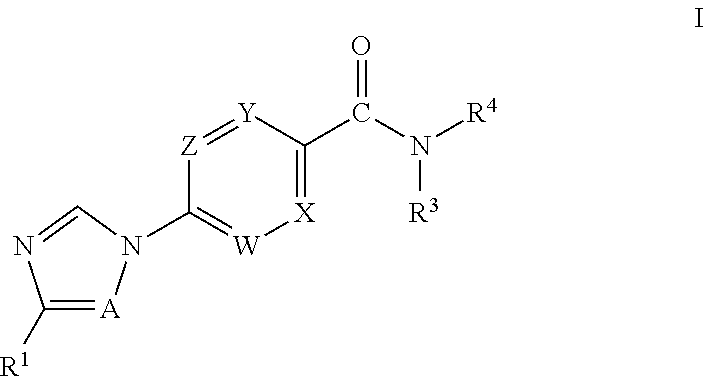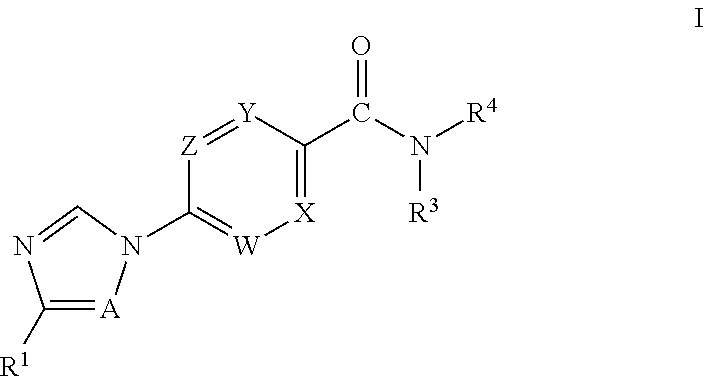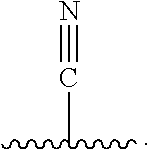Novel Heteroaryl Imidazoles And Heteroaryl Triazoles As Gamma-Secretase Modulators
a technology of gamma-secretase and heteroaryl imidazoles, which is applied in the direction of biocide, drug composition, metabolic disorder, etc., can solve the problems of ineffective treatment for halting, preventing, or reversing the progression of alzheimer's disease, and achieves increased in vivo half-life, easy preparation and detection, and greater metabolic stability
- Summary
- Abstract
- Description
- Claims
- Application Information
AI Technical Summary
Benefits of technology
Problems solved by technology
Method used
Image
Examples
example 1
6-(4-Methyl-1H-imidazol-1-yl)-N-({4-[3-(trifluoromethyl)phenyl]tetrahydro-2H-pyran-4-yl}methyl)nicotinamide (1)
[0236]
[0237]Step 1. Synthesis of 1-{443-(trifluoromethyl)phenyl]tetrahydro-2H-pyran-4-yl}methanamine (C9).
[0238]A. Synthesis of 4-[3-(trifluoromethyl)phenyl]tetrahydro-2H-pyran-4-carbonitrile (C8). [3-(Trifluoromethyl)phenyl]acetonitrile (40.7 g, 220 mmol) and bis(2-chloroethyl) ether (25.8 mL, 220 mmol) were dissolved in N,N-dimethylformamide (800 mL). Sodium hydride (60% suspension in mineral oil, 17.6 g, 440 mmol) was added in small portions over 1.5 hours, such that the temperature of the reaction did not exceed 50-55° C. After completion of the addition, the reaction mixture was stirred at 55° C. for 2 hours, and then stirred at room temperature for 18 hours. Excess sodium hydride was slowly decomposed by drop-wise addition of water until hydrogen evolution ceased. The mixture was diluted with water (2 L), and extracted with ethyl acetate (3×300 mL). The combined extra...
example 2
6-Methoxy-5-(4-methyl-1H-imidazol-1-yl)-N-[(1-phenylcyclopentyl)methyl]pyrazine-2-carboxamide (2)
[0242]
[0243]Step 1. Synthesis of 5-bromo-3-methoxy-2-(4-methyl-1H-imidazol-1-yl)pyrazine (C11). A solution of 5-bromo-2-iodo-3-methoxypyrazine (which may be prepared according to Garg, N. K. et al., J. Am. Chem. Soc. 2002, 124, 13179-13184) (92 g, 0.29 mol), 4-methyl-1H-imidazole (38.5 g, 0.47 mol), K3PO4 (157 g, 0.74 mol) and trans-1,2-diaminocyclohexane (15 mL, 0.12 mol) in dioxane (300 mL) was heated at reflux under a stream of argon for 15 minutes. Copper(I) iodide (5.5 g, 29 mmol) was added, and the reaction mixture was heated at reflux for an additional 30 minutes. After cooling to room temperature, the reaction mixture was diluted with ethyl acetate (1.0 L) and chromatographed on silica (Gradient: 0% to 16% methanol in ethyl acetate) to provide the title compound. Yield: 21.7 g, 0.081 mol, 28%. 1H NMR (400 MHz, CDCl3) δ 2.28 (s, 3H), 4.15 (s, 3H), 7.53 (s, 1H), 8.08 (s, 1H), 8.38 ...
example 3
N-{[1-(4-Chlorophenyl)cyclopropyl]methyl}-6-methoxy-5-(4-methyl-1H-imidazol-1-yl)pyridine-2-carboxamide (3)
[0247]
[0248]Step 1. Synthesis of 3-bromo-2-methoxy-6-methylpyridine (C14). A mixture of 3-bromo-2-chloro-6-methylpyridine (75.4 g, 0.365 mol) and sodium methoxide (59.1 g, 1.1 mol) in absolute methanol (700 mL) was heated at reflux for 5 days. Additional sodium methoxide (1 equivalent) was added, and the mixture was heated at reflux for 2 days. The solvent was removed under reduced pressure, and the residue was partitioned between water and dichloromethane. The organic layer was washed with water, dried over sodium sulfate, filtered and concentrated to provide the title product. Yield: 70.3 g, 0.348 mol, 95%.
[0249]Step 2. Synthesis of 5-bromo-6-methoxypyridine-2-carboxylic acid (C15). Selenium dioxide (72.3 g, 0.696 mol) was added to a solution of 3-bromo-2-methoxy-6-methylpyridine (C14) (70.3 g, 0.348 mol) in Dowtherm (300 mL). The reaction mixture was heated at 200° C. for 3 ...
PUM
| Property | Measurement | Unit |
|---|---|---|
| pH | aaaaa | aaaaa |
| pressure | aaaaa | aaaaa |
| temperature | aaaaa | aaaaa |
Abstract
Description
Claims
Application Information
 Login to View More
Login to View More - R&D
- Intellectual Property
- Life Sciences
- Materials
- Tech Scout
- Unparalleled Data Quality
- Higher Quality Content
- 60% Fewer Hallucinations
Browse by: Latest US Patents, China's latest patents, Technical Efficacy Thesaurus, Application Domain, Technology Topic, Popular Technical Reports.
© 2025 PatSnap. All rights reserved.Legal|Privacy policy|Modern Slavery Act Transparency Statement|Sitemap|About US| Contact US: help@patsnap.com



